Link: Learn more about The Blue Business® Plus Credit Card from American Express or Ink Business Unlimited® Credit Card
I’d argue that the two best no annual fee business credit cards for everyday spending are The Blue Business® Plus Credit Card from American Express (review) and the Ink Business Unlimited® Credit Card (review). In this post I wanted to do a comparison of them, to help anyone who may be deciding which card is a better fit. Both are compelling, and while there’s some overlap, they’re very different.
In this post:
Should you get the Amex or Chase no annual fee business card?
Credit card issuers typically create products that compete with one another, so it can at times be tough to decide which card is best. Let’s compare various aspects of the Ink Business Unlimited Card and Blue Business Plus Card, ranging from the annual fees, to the welcome bonuses, to eligibility, to return on spending, to perks.
Comparing annual fees
Both the Ink Business Unlimited Card and Blue Business Plus Card have no annual fees (Rates & Fees), which is awesome. It always amazes me how often the best cards for spending also don’t cost you anything. You can’t beat having a no annual fee card.
Winner: This is an area where both cards tie.
Comparing welcome bonuses & offers
The Blue Business Plus Card is currently offering a welcome bonus where you can earn 15,000 Membership Rewards® points after you spend $3,000 in eligible purchases on the Card within your first 3 months of Card Membership. Keep in mind that this is a card you get for the ongoing value it offers, rather than the bonus. The card directly earns Amex Membership Rewards points, which can be transferred to airline & hotel partners. I value those points at 1.7 cents each, so to me, the bonus is worth $255.
Meanwhile, the Ink Business Unlimited Card is currently offering a welcome bonus of 75,000 points after spending $6,000 within three months. In conjunction with a card earning Ultimate Rewards points, the points earned on this card can be converted into Ultimate Rewards points, which can be transferred to airline & hotel partners. Assuming those points are transferable, I value them at 1.7 cents each, so to me, that bonus is worth a massive $1,275.
Winner: The Ink Business Unlimited wins by a long shot in this regard.

Comparing eligibility
Different card issuers have different policies when it comes to card approvals.
The welcome bonus on the Blue Business Plus Card is “once in a lifetime.” The good news is that applying for the card doesn’t count toward Chase’s 5/24 rule, meaning that getting this card doesn’t impact your ability to get approved for a Chase card in the future. Furthermore, anecdotally I find that American Express business cards are among the easiest to be approved for.
When it comes to the Ink Business Unlimited Card, the card could be subjected to the 5/24 rule (though it’s no longer consistently enforced). One cool thing about Chase Ink Business cards is that you can earn the bonus on cards multiple times, and you can even pick up cards for both a corporation and a sole proprietorship.
Winner: The Blue Business Plus is probably easier to get approved for, though it’s cool how you can get the Ink Business Unlimited (and earn the bonus) multiple times, and for multiple businesses.
Comparing return on spending
This is an area where both cards shine (though note that both cards have foreign transaction fees, so I don’t recommend using them for purchases abroad).
The Blue Business Plus Card offers 2x points on the first $50,000 spent every calendar year, making it one of the most rewarding Amex cards. After that, the card earns one point per dollar spent. I consider this to be in line with the most rewarding cards out there for the first $50,000 spent every calendar year, since I value the return at 3.4%. The catch is that you’re capped at earning those double points on the first $50,000 spent, and after that the card just becomes average.
Meanwhile, the Ink Business Unlimited Card offers 1.5x points per dollar spent with no limits. If you just have the Ink Unlimited then points can be redeemed for one cent each. However, if you have the card in conjunction with a card earning Ultimate Rewards points, like the Chase Sapphire Preferred® Card (review), Chase Sapphire Reserve® (review), or Ink Business Preferred (review), then points can be redeemed for 1.25-1.5 cents each toward the cost of a travel purchase through Chase Travel℠, and can be transferred to the Ultimate Rewards airline and hotel partners.
For example, if you have it in conjunction with the Chase Sapphire Reserve then you can redeem points for 1.5 cents each toward the cost of any travel purchase, meaning you’re looking at a 2.25% return. You can do even better with some of Chase’s travel transfer partners.
Winner: It really depends. Assuming you value points similarly to how I do, then the Blue Business Plus is better if you spend $50,000 or less per year in non-bonused categories. However, if you spend a lot more, then the Ink Unlimited is probably a better option. Or since these are no annual fee cards, you can get the best of both worlds, and you can put $50,000 annually on the Blue Business Plus, and put remaining spend on the Ink Business Unlimited.

Comparing perks
These are both no annual fee cards that are incredibly rewarding for spending, so there aren’t that many perks beyond that.
I’d note that the Blue Business Plus Card gives you access to the Amex Offers programs, which can save you money and earn you bonus points for all kinds of purchases. This program saves me hundreds of dollars per year on some cards.
Meanwhile, the Ink Business Unlimited Card offers primary collision damage waiver coverage for rental cars, which is pretty rare for a no annual fee card. There’s also the Chase Offers program, which could prove useful, but not as valuable as Amex Offers, in my experience.

Bottom line
Both the Blue Business Plus Card and Ink Business Unlimited Card are incredible business cards. I have both the Blue Business Plus and the Ink Business Unlimited in my credit card portfolio, and over the years have gotten lots of use from both of them.
The way I view it, the Blue Business Plus is pretty easy to get approved for and is the single best business card for the first $50,000 spent every calendar year. The card also directly earns Amex Membership Rewards points, so you don’t need to have it in conjunction with another card to maximize points (you could even use it as a hub card for keeping Membership Rewards points when closing other accounts).
Then the Ink Business Unlimited is the best no annual fee business card for everyday spending with no caps, assuming you have it in conjunction with one of the cards earning Chase Ultimate Rewards points. The card has an excellent welcome bonus (in a completely different league than the Blue Business Plus), so if you can get it, there’s huge potential here.
Where do you stand — do you prefer the Amex Blue Business Plus or Chase Ink Business Unlimited?
The following links will direct you to the rates and fees for mentioned American Express Cards. These include: The Blue Business® Plus Credit Card from American Express (Rates & Fees).





For me, the important part of BBP was that it maintains access to MR if I decide to cancel the Platinum Bus.
Up to $50k per year, it's 2X. Doing the math, at $100k of spending, it works out to 1.5X. So, for businesses with modest spending in non-bonus categories, the BBP is absolutely fine. If one gets above that level of non-bonus spending, maybe one looks at something else. And, as you infer, one does not need a second card to be able to transfer points to loyalty programs. An alternative is using a personal card for business: Citi Double Cash.